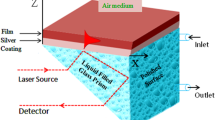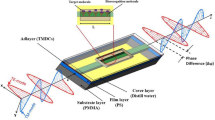Abstract
The sensing performance of liquid filled prism coupled standard metal clad planar waveguide sensors in presence of transition metal dichalcogenide materials are studied and compared with similar polymer waveguides. For comparison point of view, the film thickness of SiO2 waveguide and polymer waveguides is so chosen that they have same effective refractive index. The modal equation and other necessary formulae of proposed waveguides are derived using boundary matching technique. Our analysis shows that the sensing performances of both waveguides are improved in presence of an adlayer of transition metal dichalcogenide material. In our all considered 2D materials, monolayer of WS2 material shows maximum sensitivity and quality parameter for SiO2 waveguide and WSe2 material shows maximum sensitivity and quality parameter for polystyrene waveguide. Hence, Tungsten based 2D materials always give better sensing performance than the Molybdenum based 2D material in our all considered cases. Also, the analysis shows that the sensing performance of SiO2 guiding layer waveguide is better than the polymer guiding layer waveguide. The obtain maximum sensitivity and quality parameter of our proposed SiO2 waveguide in presence of WS2 material is 4410/RIU and 2138/RIU, respectively.
Similar content being viewed by others
Data Availability
No. associated data.
References
Dutta A, Deka B, Sahu PP Engineering materials planar waveguide optical sensors from theory to applications
Yoon JY, Kim B (2012) Lab-on-a-chip pathogen sensors for food safety. Sensors (Switzerland) 12:10713–10741
Urbancova P, Chylek J, Hlubina P, Pudis D (2020) Guided-mode resonance-based relative humidity sensing employing a planar waveguide structure. Sensors (Switzerland) 20:1–13
Liedberg BO, Nylander C, Lundstrom I (1983) Surface plasmon resonance for gas detection and biosensing*
Lin Y, Lu F, Tu Y, Ren Z (2004) Glucose biosensors based on carbon nanotube Nanoelectrode ensembles. Nano Lett 4:191–195. https://doi.org/10.1021/nl0347233
Gut K, Nabaglo D (2009) Measurements of the attenuation by means of the scattered light of planar waveguide structure, basing on the polymer SU8 on a substrate of sodium-calcium glass. Acta Phys Pol A 116. https://doi.org/10.12693/APhysPolA.116.307
Hainberger R, Bruck R, Muellner P, et al (2009) Design of silicon and polymer photonic waveguide structures for sensing applications. In: Photonics North 2009
Verma A, Prakash A, Tripathi R (2016) Sensitivity improvement of graphene based surface plasmon resonance biosensors with chaclogenide prism. Optik 127:1787–1791. https://doi.org/10.1016/j.ijleo.2015.11.083
Yadav GC, Sharma G, Kumar S, Singh V (2017) Performance study of metallic clad planar waveguide sensors in presence of graphene layer. Optik 147:366–372. https://doi.org/10.1016/j.ijleo.2017.08.109
Kang XB, Wen LW, Wang ZG (2017) Design of guided Bloch surface wave resonance bio-sensors with high sensitivity. Opt Commun 383:531–536. https://doi.org/10.1016/j.optcom.2016.10.004
Horvath R, Pedersen HC, Skivesen N, Selmeczi D, Larsen NB (2005) Monitoring of living cell attachment and spreading using reverse symmetry waveguide sensing. Appl Phys Lett 86:1–3. https://doi.org/10.1063/1.1862756
Yadav GC, Prakash S, Sharma G et al (2018) Performance analysis of a liquid-filled glass prism-coupled metal-clad planar waveguide sensor. Appl Phys A: Mater Sci Process 124. https://doi.org/10.1007/s00339-018-2263-4
Kumar D, Singh V (2011) Theoretical modeling of a nonlinear asymmetric metal-clad planar waveguide based sensors. Optik 122:1872–1875. https://doi.org/10.1016/j.ijleo.2010.12.031
Kullab HM, Taya SA, El-Agez TM (2012) Metal-clad waveguide sensor using a left-handed material as a core layer
Hossain B, Kabir A, Rahman M et al (2021) Hybrid structure based high performance SPR sensor: a numerical approach of structure optimization for DNA hybridization. Opt Quant Electron:53. https://doi.org/10.1007/s11082-020-02650-9
Ouyang Q, Zeng S, Jiang L, Hong L, Xu G, Dinh XQ, Qian J, He S, Qu J, Coquet P, Yong KT (2016) Sensitivity enhancement of transition metal dichalcogenides/silicon nanostructure-based surface plasmon resonance biosensor. Sci Rep 6. https://doi.org/10.1038/srep28190
Maurya JB, Prajapati YK, Singh V, Saini JP (2015) Sensitivity enhancement of surface plasmon resonance sensor based on graphene–MoS2 hybrid structure with TiO2–SiO2 composite layer. Appl Phys A: Mater Sci Process 121. https://doi.org/10.1007/s00339-015-9442-3
McDonagh C, Burke CS, MacCraith BD (2008) Optical chemical sensors. Chem Rev 108:400–422
Skivesen N, Horvath R, Pedersen HC (2005) Optimization of metal-clad waveguide sensors. Sensors Actuators B Chem 106:668–676. https://doi.org/10.1016/j.snb.2004.09.014
Wu L, Guo J, Wang Q, Lu S, Dai X, Xiang Y, Fan D (2017) Sensitivity enhancement by using few-layer black phosphorus-graphene/TMDCs heterostructure in surface plasmon resonance biochemical sensor. Sensors Actuators B Chem 249:542–548. https://doi.org/10.1016/j.snb.2017.04.110
Upadhyay A, Prajapati YK, Tripathi R, et al Analysis of a metal clad waveguide sensor having metamaterial as a guiding layer. https://doi.org/10.1515/oere−2016−0009
Lebyedyeva T, Shpylovyy P, Frolov Y, Budnyk M (2020) Development and manufacture of high-sensitivity SPR sensors based on au/niobium oxide thin-film structures. In: 2020 IEEE 40th international conference on electronics and nanotechnology, ELNANO 2020 - proceedings. Institute of Electrical and Electronics Engineers Inc., pp 280–283
Acknowledgments
The author Rajiv Maurya is thankful to University Grant Commission, New Delhi for providing fellowship to pursue this work.
Funding
We also acknowledge the support from Institutions of Eminence (IoE) BHU Grant scheme No. 6031.
Author information
Authors and Affiliations
Contributions
RM has done the simulation work of the device structure and also developed the computational framework. VM helped in preparing the final draft. VS has devised the idea and helped while preparing the final draft and supervised.
Corresponding author
Ethics declarations
This article does not contain any studies involving animals or human participants performed by any of the authors.
Consent to Participate
Not Applicable.
Consent for Publication
Not Applicable.
Conflict of Interest
No conflict of interest to disclose.
Additional information
Publisher’s Note
Springer Nature remains neutral with regard to jurisdictional claims in published maps and institutional affiliations.
Rights and permissions
About this article
Cite this article
Maurya, R., Mishra, V. & Singh, V. Towards Sensing Performance of Metal Clad Planar Waveguide Sensor with Transition Metal Dichalcogenide Materials. Silicon 14, 10919–10929 (2022). https://doi.org/10.1007/s12633-022-01817-1
Received:
Accepted:
Published:
Issue Date:
DOI: https://doi.org/10.1007/s12633-022-01817-1




